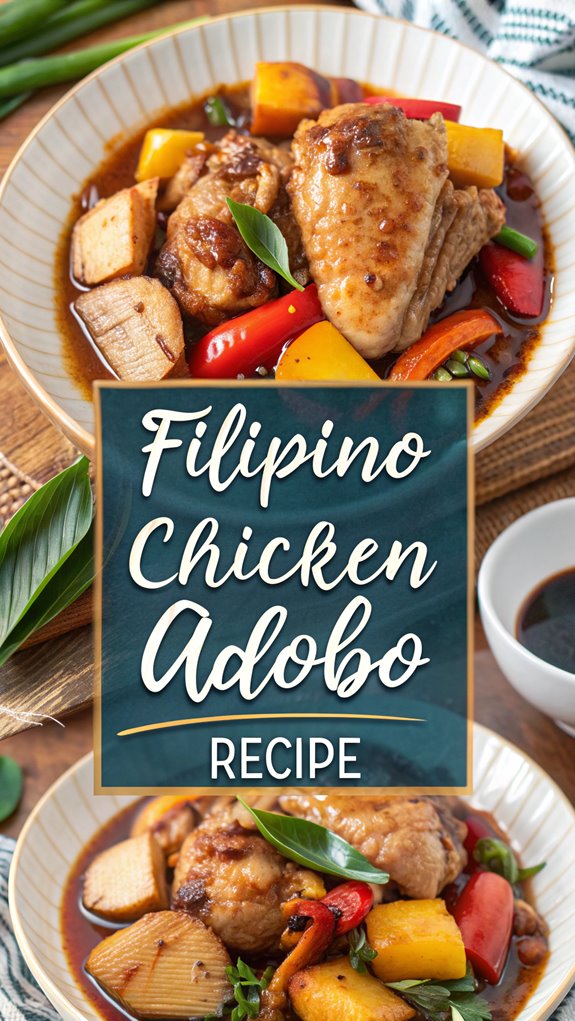Filipino Recipe Chicken
If you’re looking for a classic Filipino chicken dish, try making Chicken Adobo. Start with 2-3.5 pounds of bone-in chicken thighs. Marinate them in 4-8 tablespoons of soy sauce, 6 tablespoons of white vinegar, 3-4 bay leaves, and 1-5 garlic cloves for at least 1 hour. Once marinated, pan-fry the chicken until it’s lightly browned. Then, simmer it with the marinade and some water for 30 minutes. Add the vinegar and cook for another 10 minutes. Serve your Chicken Adobo with steamed rice for a hearty meal. You can explore variations to suit your taste preferences.
Why You’ll Love this Recipe
When you try this Filipino Chicken Adobo recipe, you’ll immediately appreciate its cultural significance and the sense of community it fosters. Adobo isn’t just a dish; it’s a reflection of Filipino history and identity.
When families gather, they often share this flavorful meal, strengthening bonds and creating memories. You’ll love how the recipe showcases Filipino creativity and resilience, making it a symbol of unity and pride. Plus, you’ll find health benefits in every bite. The chicken provides high-quality protein, while the vinegar aids digestion. Additionally, the inclusion of rice moistening Yin contributes to a balanced and nourishing meal.
With minimal prep and cooking time, this one-pot dish is perfect for busy days. You can easily adjust flavors, making it a versatile choice for any occasion. Enjoy a taste of innovation with every serving!
Recipe
Filipino Chicken Adobo Recipe
Filipino chicken adobo is a beloved dish that showcases the rich and vibrant flavors of Filipino cuisine. This savory dish is known for its unique blend of soy sauce, vinegar, garlic, and bay leaves, which come together to create a deliciously tangy and aromatic sauce that perfectly complements tender, juicy chicken.
Adobo is often served with steamed rice, making it a comforting meal that’s enjoyed by families and friends alike. The beauty of chicken adobo lies in its versatility; there are countless variations you can explore based on regional preferences and personal taste. Some recipes include the addition of coconut milk for creaminess, while others may incorporate vegetables to enhance the nutritional value.
This recipe will guide you through the traditional method of preparing chicken adobo, ensuring a flavorful and satisfying dish that’s sure to impress. Notably, coconut milk can be a popular addition to enhance the flavor profile of this dish.
Ingredients:
– 2-3.5 pounds bone-in chicken thighs
– 3-4 pieces dried bay leaves
– 4-8 tablespoons soy sauce
– 6 tablespoons white vinegar
– 1-5 cloves garlic, peeled
Cooking Instructions:
1. Begin by marinating the chicken thighs in a large bowl with soy sauce, garlic, and bay leaves. Allow the chicken to marinate for at least 1 hour, or for best results, refrigerate and marinate for 4 hours or overnight.
2. After marination, drain the chicken and pat it dry with paper towels to remove excess marinade.
3. In a large skillet or pan, heat a small amount of oil over medium-high heat. Pan-fry the marinated chicken for about 2 minutes on each side until lightly browned.
4. Pour in the remaining marinade along with a splash of water to help create the sauce. Add the dried bay leaves and whole peppercorns. Bring the mixture to a boil, then reduce the heat to low and let it simmer for about 30 minutes or until the chicken is tender.
5. After simmering, add the white vinegar to the pan. Stir gently to combine and continue to cook for an additional 10 minutes, allowing the flavors to meld together.
6. Once the chicken is cooked through and the sauce has thickened slightly, remove from heat and serve with steamed rice.
For the best results, be careful not to overcook the chicken, as it can become dry. Allowing the chicken to marinate for longer enhances the flavor, so don’t rush this step.
Additionally, feel free to adjust the amount of soy sauce and vinegar according to your taste preference. Enjoy your delicious Filipino chicken adobo!
Final Thoughts
While enjoying a plate of chicken adobo, you can’t help but appreciate its deep cultural significance and rich history. This dish symbolizes the resilience and resourcefulness of the Filipino people.
Here are some key points to remember about adobo:
- Cultural Importance: It represents Filipino identity and brings families together.
- Historical Roots: Originating from pre-colonial methods, adobo evolved with influences from Spanish and Chinese cuisines. Its creation as a preservation technique showcases the ingenuity of early Filipino cooks.
- Versatility: With numerous variations, adobo caters to all tastes and budgets.
- Community Connection: Sharing meals is essential in Filipino culture, emphasizing hospitality.
Ultimately, chicken adobo is more than just food; it’s a representation of heritage and unity, making it a cherished dish in Filipino homes.
Frequently Asked Questions
What Are the Best Side Dishes to Serve With Filipino Chicken?
When serving chicken, consider pairing it with garlic fried rice for flavor, lumpia for crunch, or ensaladang mangga for freshness. These vibrant sides elevate your meal, creating a delightful and memorable dining experience.
Can I Use a Different Protein Instead of Chicken?
You can switch chicken for various proteins like tofu, shrimp, or even bangus. Each alternative brings unique flavors and textures, so feel free to experiment and create exciting new dishes that suit your taste!
How Do I Store Leftovers Properly?
To store leftovers properly, use airtight containers, keep them refrigerated at 5°C or below, and consume them within 3-4 days. For longer storage, freeze them, ensuring they’re well-sealed to maintain quality.
What Is the History Behind Filipino Chicken Dishes?
You’ll find the history of Filipino chicken dishes fascinating, blending indigenous techniques with Spanish and Chinese influences. Ingredients like vinegar and soy sauce create unique flavors, showcasing the rich culinary heritage that evolves through generations.
Are There Vegetarian Alternatives to This Recipe?
You can explore innovative vegetarian alternatives like tofu, jackfruit, or seitan. Marinade them with traditional flavors, and they’ll transform your dishes, providing that satisfying texture and taste without compromising on authenticity. Get creative!
Filipino Recipe Chicken
Ingredients
- - 2-3.5 pounds bone-in chicken thighs
- - 3-4 pieces dried bay leaves
- - 4-8 tablespoons soy sauce
- - 6 tablespoons white vinegar
- - 1-5 cloves garlic peeled
Instructions
- Begin by marinating the chicken thighs in a large bowl with soy sauce, garlic, and bay leaves. Allow the chicken to marinate for at least 1 hour, or for best results, refrigerate and marinate for 4 hours or overnight.
- After marination, drain the chicken and pat it dry with paper towels to remove excess marinade.
- In a large skillet or pan, heat a small amount of oil over medium-high heat. Pan-fry the marinated chicken for about 2 minutes on each side until lightly browned.
- Pour in the remaining marinade along with a splash of water to help create the sauce. Add the dried bay leaves and whole peppercorns. Bring the mixture to a boil, then reduce the heat to low and let it simmer for about 30 minutes or until the chicken is tender.
- After simmering, add the white vinegar to the pan. Stir gently to combine and continue to cook for an additional 10 minutes, allowing the flavors to meld together.
- Once the chicken is cooked through and the sauce has thickened slightly, remove from heat and serve with steamed rice.



